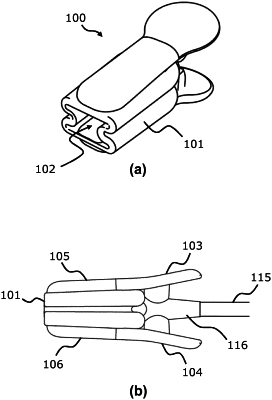| CPC A61B 5/14552 (2013.01) [A61B 5/683 (2013.01); A61B 2562/12 (2013.01)] | 20 Claims |

|
1. A device for measuring a physiological parameter of a subject, comprising:
a hollow elastic sleeve comprising a cavity adapted to enclose a limb of the subject, the cavity extending longitudinally between a distal end and a proximal end and having a closed-loop cross-section, the hollow elastic sleeve having a predetermined shape to which the sleeve returns due to its resilience when an external force deforming the sleeve ceases to be applied thereto;
a first and a second arm, each arm comprising a hinge portion located at an intermediate position of the arm between a coupling portion and a handle portion, the coupling portion of the first and the second arm being adapted to be coupled, respectively, to a first and a second longitudinal section of the hollow elastic sleeve from said proximal end, the first and second longitudinal sections being diametrically opposite to each other along a clamping direction extending across the cross-section of the cavity; and
a physiological sensor arranged within the cavity of the hollow elastic sleeve and configured for interacting with the limb enclosed in said cavity;
wherein, when the first and the second arms are coupled to the hollow elastic sleeve, the hollow elastic sleeve holds the first and the second arms and causes the hinge portions of the first and the second arms to engage each other to form a hinge mechanism so that, by applying a compression force on the handle portion of the first and second arms, the first and second arms rotate relative to each other about the hinge mechanism expanding the cross-section of the cavity at said distal end, thereby allowing the limb to be received in the cavity through said distal end, and, by ceasing said compression force, the resilience of the hollow elastic sleeve causes the first and second arms to rotate relative to each other in the opposite direction than following compression, thereby enclosing the limb in the cavity; and
wherein the hinge portions of the first and second arms, when engaged to each other, are further configured to slide relative to each other along a tapered connecting portion, so that the separation between the first and second arms along said clamping direction can be adjusted.
|